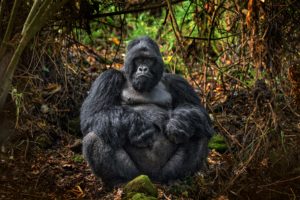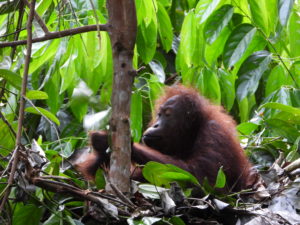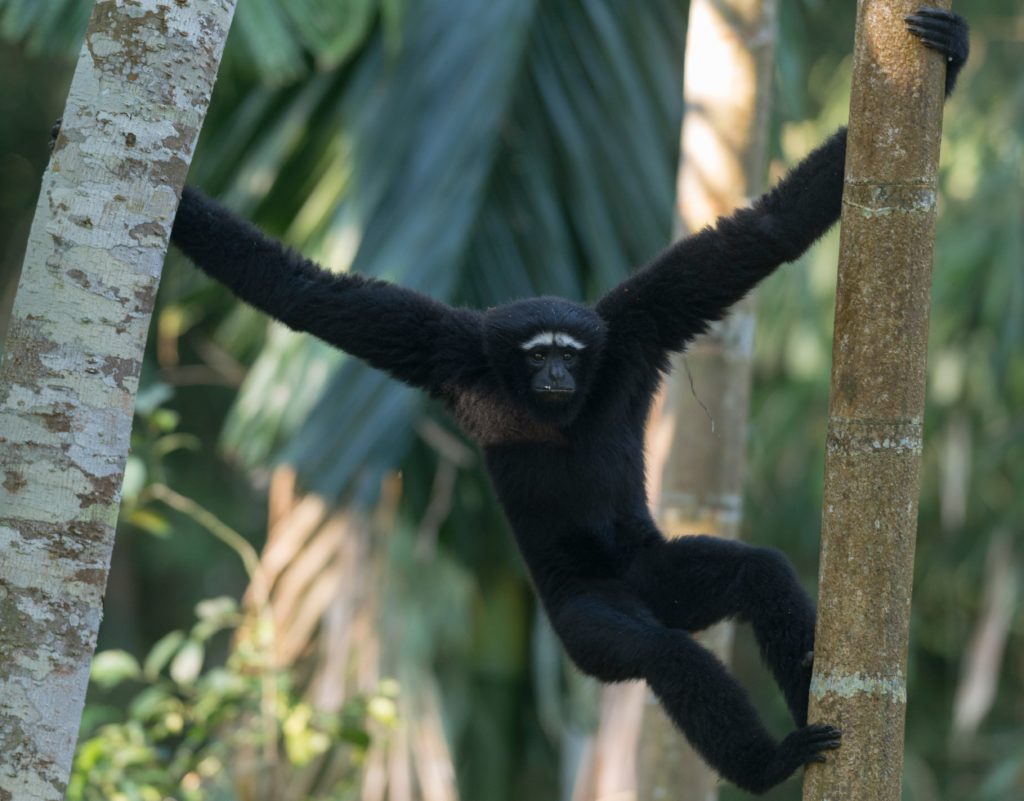
High above the ground, amidst the dense forest canopy cover of South and East Asia, you may be lucky enough to spot one of the most intriguing ape species on the planet. Gibbons live among the treetops and move by brachiating, or swinging with their arms. They can reach speeds upwards of 35 miles per hour (Usain Bolt’s maximum speed was 27 mph) and have been known to jump across gaps as large as 30 feet. Unfortunately, these fascinating and elusive apes are one of the most threatened families of primates, with 19 of the 20 species listed as endangered or critically endangered.
The fast-moving gibbons are vulnerable when they descend from the treetops to the ground, which they must do when forests are fragmented into disconnected patches. Linear infrastructure (LI)— such as roads, railways, and power lines—is a key contributor to this habitat loss and fragmentation, which pose a major threat to primates worldwide. As new and expanded LI continues to explode across the globe, especially in developing countries, gibbons will likely need to descend more and more frequently from the safe harbor of the forest canopy to brave roads and railways, putting them at increased risk of collisions with vehicles or trains, disease transmission, electrocution, predators, or hunting and poaching by humans. The fragmentation of habitat can also lead to the isolation of ape populations, which has a number of ramifications, including loss of genetic diversity.
If the infrastructure surge continues unchecked, less than 10% of the African ape range habitat will be left intact by 2030.
This threat from infrastructure development is compounded by other disturbances to ape habitat. For example, in July 2022, the Democratic Republic of Congo announced plans to expand oil and gas permits in vital wildlife habitats, including the Virunga UNESCO World Heritage Site, one of the focal landscapes of the A.P.E. Project and home to one of the last remaining populations of mountain gorillas. The implications of further wildlife disruption and impending development of LI needed for oil operations pose a significant threat to all apes, potentially leading to their displacement, changes in behavior, habitat loss, and mortality. If the infrastructure surge continues unchecked, less than 10% of the African ape range habitat will be left intact by 2030.1

Apes, and local communities, require healthy, intact forests for survival. In response to rising threats, the Center for Large Landscape Conservation is executing a one-year pilot project to Assess, Protect and Evaluate the impacts of roads, railways, and power lines on endangered gibbons and great apes. The A.P.E. Project, funded by a generous grant from the Arcus Foundation, aims to appraise threats and assemble best practices to reduce harm from existing and future linear infrastructure in ape habitat in three critical ape landscapes.
The project uses a three-pronged research effort to protect the apes and people living in the forests of these ranges. The Center’s A.P.E. Project team is researching risks to ape habitat and ecological connectivity by analyzing policy, mapping the impacts of planned LI, and engaging with partners on the ground to better understand gaps in data and local capacity to safeguard apes and gibbons from the LI development.
The team will focus on three pilot landscapes and three representative species: orangutans of Eastern Sabah, Borneo (Malaysia); Hoolock gibbons of Northern India; and gorillas within the transboundary Virunga landscape in Africa. By learning from the experiences of a range of stakeholders across these diverse regions around the globe, the team is compiling best practices for LI development that minimize the impact on apes, their habitat, and the people they share it with. These best practices can serve great ape and gibbon conservationists everywhere.
Some of the project goals include promoting better decision-making around LI to enable avoidance of key ape habitat, or—if that is not possible—better planning and mitigation of threats at the national and regional level. The team will produce predictive LI models in the three landscapes to spotlight priority areas where development is likely to have the greatest impact. They are also partnering with on-the-ground experts to develop appropriate, science-based training for those involved with conservation or infrastructure development in the three focal landscapes and beyond.

“Ecological connectivity is at the root of every discussion here at the Center, and we see poor planning in linear infrastructure development in direct conflict with that goal,” says the Center’s Conservation Project Director, Dr. Megan Parker. “Good scientific data can be used to avoid building or expanding infrastructure in areas of importance for biodiversity; but when that’s not possible, proven mitigation measures can be added to reduce the impacts.”
Parker says the project’s objective is to better prepare and train scientists, LI developers, policymakers, conservation practitioners, and civil society with the knowledge and tools to avoid and mitigate harmful LI projects.
“The A.P.E. Project—Assess. Protect. Evaluate.—is aptly named to reflect our commitment to nature’s resilience and the survival of these magnificent ape species,” says Parker.
The Arcus Foundation is committed to advancing social justice for LGBTQ people around the world and to protecting the world’s great apes and gibbons. You can learn more about the foundation at arcusfoundation.org
Photo, top: Hoolock gibbon, India. Adobe Stock
1 Junker et al., 2012; Nellemann and Newton, 2002



